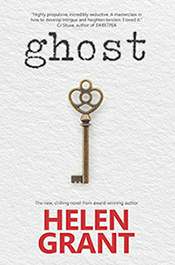I have been a fan of M.R.James' ghost stories since I was a child, and when we moved to Germany in 2001 we found ourselves living not far from the setting of one of them, The Treasure of Abbot Thomas. The tale concerns treasure concealed in a well at Steinfeld abbey and protected by a grotesque supernatural guardian.
I have written several articles about Steinfeld and I became very interested in the topic of wells and their place in local folklore. In 2005 I wrote an article about it which was published in the Newsletter. It is not one of those articles available on the Newsletter's website, and the issue is now out of print. Therefore, with the permission of editor Rosemary Pardoe, I am pleased to reproduce it here.
"Depositum
Custodi"
Wells and Treasure in German Folklore
"...I have tried to
make my ghosts act in ways not inconsistent with the rules of folklore,“ wrote
M.R.James in the introduction to his Collected
Ghost Stories. MRJ never visited Steinfeld Abbey, scene of "The
Treasure of Abbot Thomas“, and there are inconsistencies between the Abbey as
portrayed in the story and the Abbey in reality (cf. G&S Newsletter 5, pp. 4-8); however, his tale of treasure
hidden in a well and guarded by a supernatural creature is thoroughly
consistent with German folklore, and specifically that of the Eifel, where the
Abbey is situated.
The fairy tales collected
by the Brothers Grimm include a number featuring the inhabitants of wells. In
"Das blaue Licht“ ("The
Blue Light“), a soldier jumps down a well to retrieve a blue light for a witch
he is forced to serve; when he lights his pipe at the blue light, a dwarf
appears to do his bidding. With the dwarf’s assistance the soldier acquires the
witch’s store of gold and silver, and eventually marries the king’s daughter. In
the better-known tale "Frau Holle“,
the heroine jumps down a well after a lost spindle, and finds herself in a
wonderful land; she enters the service of Frau Holle and for her good work
receives a shower of gold pieces and a golden dress. Frau Holle’s gold is not
freely given to all, however: the ugly and lazy sister who enters Frau Holle’s
service in the hope of a fortune receives a shower of black pitch instead!
"Der Froschkönig“ („The Frog King“), also known as "Eiserne (Iron) Heinrich“, is a variation of the Frog Prince story, in which a frog
recovers the princess’s golden ball from a well. The well in this version is
situated in a great dark forest, and the frog which dwells in it has a
distinctly unpleasant appearance, "stretching forth ist big, ugly head
from the water“. Later, as the princess was at dinner, "something came
creeping up the marble steps, splish splash, splish splash“; when the princess
opens the door she slams it again and sits down at the table once more, her
heart beating violently with terror. Shades of that "horrid, grotesque
shape – perhaps more like a toad than anything else“ in "Abbot Thomas“...
From the Eifel town of
Kall, not far from Steinfeld, comes the tale of the "Kaller Erdmännchen“, the "Little Man of the Earth“[1],
which features a kind of "well of treasure“. The story goes that a
starving widow sent her eldest son out to beg; the young man met a little man
dressed as a miner who led him to a deserted shaft full of precious metal. The
young man could remove and sell as much as he liked, on condition that he told
no-one where the treasure had come from. Many people, curious at the young
man’s sudden wealth, tried to find out where he was obtaining it, but he
refused to tell. Finally some of them contrived to get him drunk, and he
revealed the secret. The next morning when the young man descended into the
hole, the little man was waiting for him, glaring with anger... A little later,
the men who had discovered the secret came and eagerly hauled up the bucket on
its winch from the hole; in it lay
no metal but the young man’s dead body. After that none dared enter the shaft,
and at last the entrance became overgrown and lost. At the end of the story, as
in "The Treasure of Abbot Thomas“, the site of the treasure is nce more
left to become overgrown.
In the mediaeval town of
Bad Münstereifel, some ten miles west of Steinfeld, there is a local tradition
that ecclesiastical treasure was hidden in a well somewhere in the town. As in
MRJ’s story, the tale of the Bad Münstereifel treasure also has its Mr.
Somerton, in the form of local businessman and philanthropist Alex Schlierf.
Herr Schlierf kindly agreed to share his experiences with the G&S Newsletter[2].
The story of the
Bad Münstereifel treasure has been handed down orally.[3]
Tales of hidden treasure are about as old as mankind, dating back to the times
when precious items were buried with their owner in his grave. A well,
especially one located under a house, is a particularly good hiding-place,
since anything in it is protected even in the event of the house burning down.
According to local legend, the nuns of the Carmelite convent in Bad
Münstereifel hid treasure belonging to the church in a well when the French
invaded the town[4] – and the treasure
still lies there, awaiting discovery.
Bad Münstereifel
has two public wells, with winch and bucket still extant, in the south end of
the town. What is not so obvious to the casual visitor is that most houses in
the old town also had their own well in the cellar.[5]
There were many advantages in having one’s own well: apart from the saving in
the labour of fetching water from a public well, the inhabitants could deal
with a house fire more quickly, and last out longer in the event of a siege. These
wells were capped according to new sanitary regulations after World War II, and
water pipes were installed instead. Whatever lay within a particular well was
seemingly sealed off forever.
Alex Schlierf was
born in his family home in the town in the 1950s. As an apprentice of fourteen
he listened to older me relating tales dating back a hundred years, which had
been handed down from their own grandparents – tales such as that of the grisly
discovery made under the crypt of the Jesuit church in the 1920s, for example[6].
There was also an unsubstantiated rumour that a number of skeletons of unwanted
babies had been found close to a wall in the Heisterbacher Strasse.
In 1973, Herr
Schlierf acquired the house in which his business, Optik Alex Schlierf, is now conducted. The building stands on the
site of a mediaeval mill belonging to the collegiate church in Bad
Münstereifel, extensively renovated in the eighteenth century. Alex Schlierf
was convinced that there was a well somewhere in the cellars of the house.
Could it be the one in which the nuns’ treasure was concealed? Since the
mediaeval mill was church property, and it stands only a short distance from
the site of the old convent, it seemed a likely candidate. With an enthusiasm
of which Mr.Somerton would be proud, Herr Schlierf had the floor tested, and
after some false starts a well-shaft was
found and excavated. Alas! The excavations revealed a lot of masonry and part
of the mill-wheel axle, but no treasure. If the treasure of the church really was deposited in a well in the town,
thus far it has obeyed the injunction, keep
that which is committed to thee. [7]Readers
of the G&S Newsletter may take
the view that this is for the best...
Finally, here are
some general observations about wells in the mediaeval Eifel from Herr
Schlierf, which provide interesting background to the location of "The Treasure of Abbot Thomas“:
Having one’s own water
supply (as did Abbot Thomas) increased the capital value of a building.
Well-building in itself appears to have been a hazardous occupation, quite
likely to produce its own ghosts. The procedure was to dig downwards, sometimes
as far as fifteen metres, supporting the excavated sides of the well with
stones as the work proceeded. The stones were not cemented, and therefore there
was always the risk that the sides would collapse, or that the water table
would suddenly break through. Many workers never got out of the well at all! The
completed well also represented a risk to the unwary: some wells were
bottle-shaped, and others had a bend in the neck. Either way, if anyone fell
in, their chances of ever getting out again were slim.
Furthermore, all the wells
in a town like Bad Münstereifel were connected, since each householder sunk his
well into the water table which also supplied his neighbour’s house.
Co-operation was vital; if, for example, an animal fell into the well at the
top of the street and was left to decay, it would poison every well further
downstream. It was an arrangement which could only work if the inhabitants of
the town shared their water responsibly. For Alex Schlierf, this is significant:
"Teilen ist der grösste Schatz“ –
"The greatest treasure of all is sharing.“
A well could be valuable,
very dangerous, and sometimes the repository of secrets – whether hidden wealth
or a tiny skeleton – in fact, the ideal location for Abbot Thomas’s treasure
and its unpleasant guardian...
Acknowledgements:
With thanks to Herr Alex
Schlierf.
[1] The story of
the "Kaller
Erdmännchen“ is retold by Hans Peter Schiffer in his collection of Eifel
folktales, Die Drachenlaterne (1998).
The Grimm quotations are from Grimms
Märchen (Knaur Verlag, 2003); the translations are mine.
[2] As the
original interviews were in German, I have related the content as reported
speech.
[3] I have not
been able to find any record of the story in collections of local folk tales,
etc. This may be its first appearance in print!
[4] This gives a
probable date of 1689, since that year the castle was burnt by invading French
troops. The fear of war and plundering was instrumental in the history of the
Steinfeld glass (see G&S Newsletter 5),
which was repeatedly removed and hidden.
[5] It is
possible to see the location of one of these wells in the local history museum,
one of the oldest houses in Germany. It is, of course, now capped, but the staff
report that a few items were found in it, including coins.
[6] Allegedly,
three skeletons were found with bound hands!
[7] It seems
unlikely, however, that Alex Schlierf’s treasure hunting will end here. He lent
me a document written by his daughter, in which she describes how she and her
father explored another well, in his parents’ house in the Wertherstrasse. The
well was only accessible via a hole in the cellar wall, though which the water
could be seen gleaming. Undaunted, Herr Schlierf used a waterproof torch on the
end of a rod and line to explore the waters!
Above: well in the Heisterbacher Strasse, Bad Münstereifel
Above: gazing down the well!










No comments:
Post a Comment